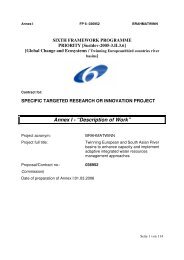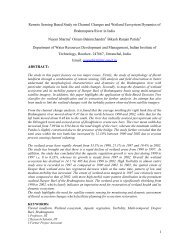4. Lasut 2005 Creative thinking - Brahmatwinn
4. Lasut 2005 Creative thinking - Brahmatwinn
4. Lasut 2005 Creative thinking - Brahmatwinn
You also want an ePaper? Increase the reach of your titles
YUMPU automatically turns print PDFs into web optimized ePapers that Google loves.
Techniques for preference elicitation from different actors were identified and grouped as following<br />
according to their distinctive features:<br />
• Strategic Options Development and Analysis (SODA)<br />
• Hodgson’s Hexagon<br />
• Vennix’s Causal Modelling<br />
• Repertory Grid Technique (RGT)<br />
• Delphi technique (DELPHI)<br />
• Nominal Group Technique (NGT).<br />
The structured comparison of various CM techniques is presented in Table 1. The techniques<br />
described in the table are chosen representation for the broad scope of different application<br />
approaches and tools. During the process of application the techniques are usually modified by the<br />
facilitators to suit the specific purposes and conditions, but still they keep their main distinctive<br />
features.<br />
The main similarities are concerning the general framework of the elicitation process, in particular<br />
all techniques include main phases such as: brainstorming, clustering and analysis of causal loops.<br />
The differences are regarding the way the information is gathered, visualised and presented back to<br />
other participants. Some techniques are more structured (Delphi, RGT, SODA) than others<br />
(Hodgson’s Hexagons, Vennix). Some like NGT are more suitable to interactive, face-to-face<br />
meetings. Others like SODA and Hodgson’s Hexagons use special visual techniques like colour<br />
coding for the better analysis.<br />
NGT has not been presented in the table due to its similarity to the Delphi technique. NGT is a<br />
structured technique preformed in face-to-face meetings, an effective way to generate a large<br />
quantity of creative new ideas and to take decisions in groups meeting face to face (eg. Delbecq,<br />
ect, 1975). It is helpful in identifying problems, postulating and exploring policies and problem<br />
solutions with stakeholders participation. It includes the following stages: presentation of issue<br />
(development of focus/ trigger question), individual reflection and brainstorming (silent generation<br />
of ideas and their sharing in a structured way – round robin till all the ideas are recorded and no<br />
discussion and justification of ideas), consolidation and review of ideas (discussion and clarification<br />
of all ideas), ranking of ideas, compilation of results.<br />
6





